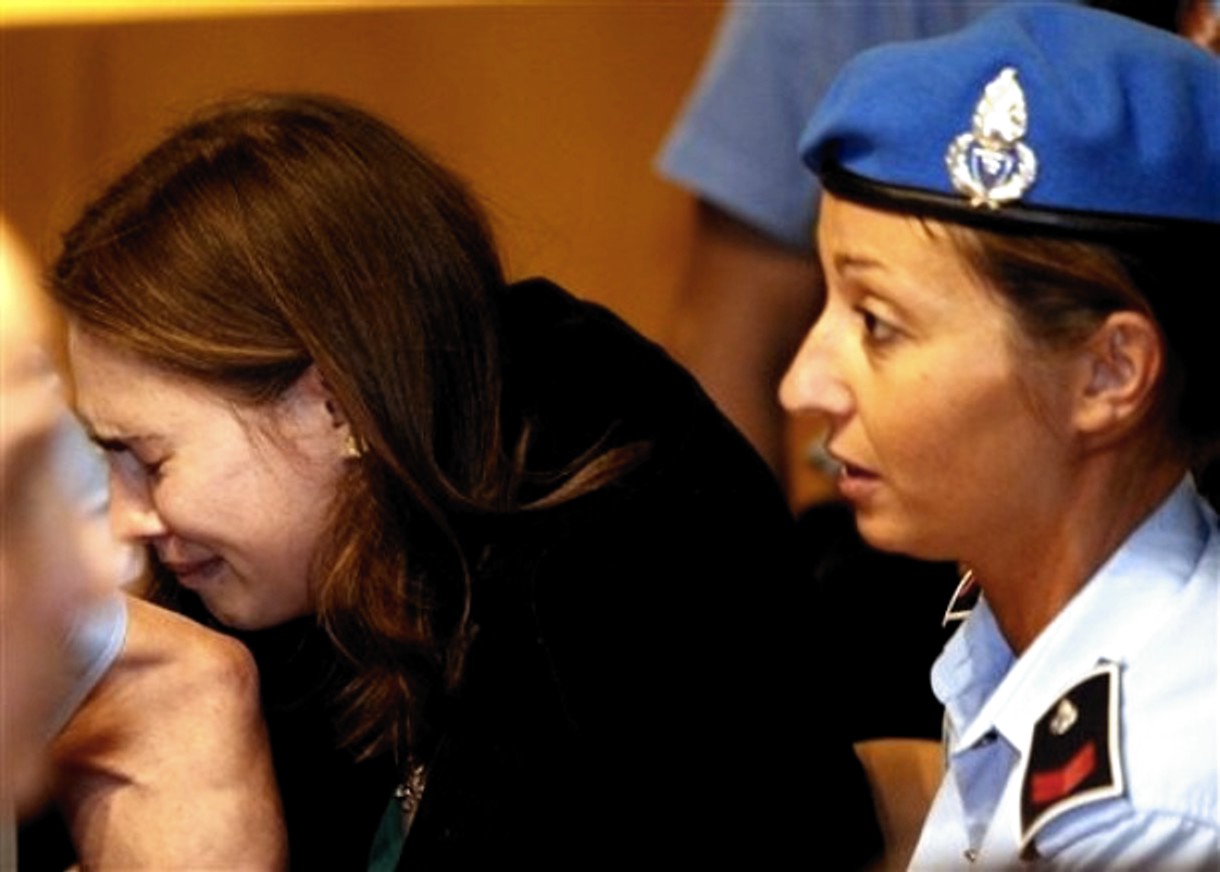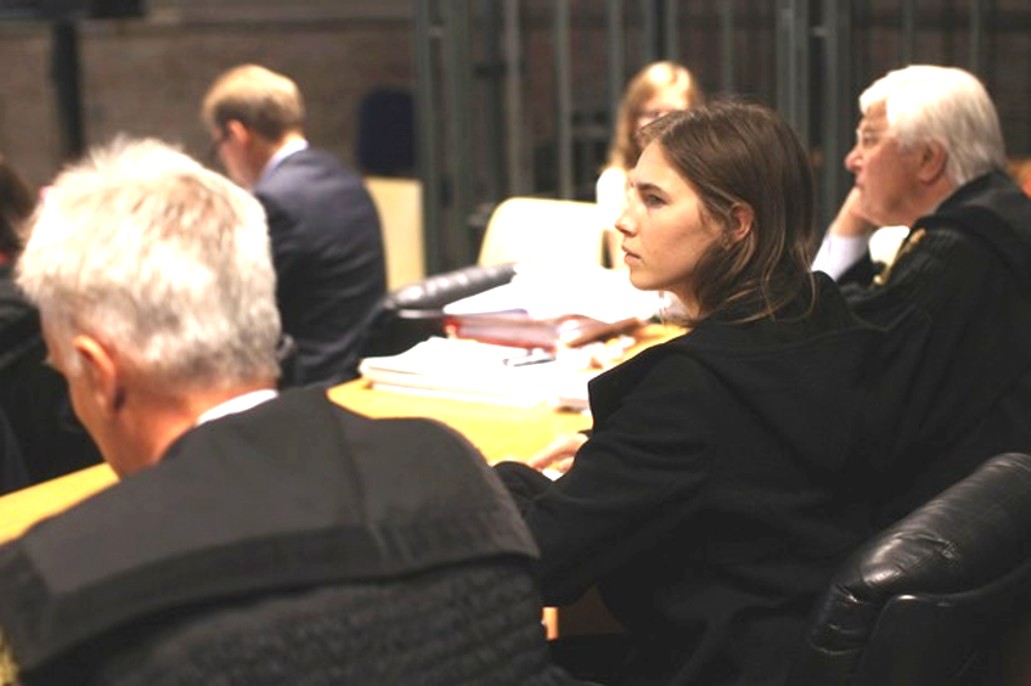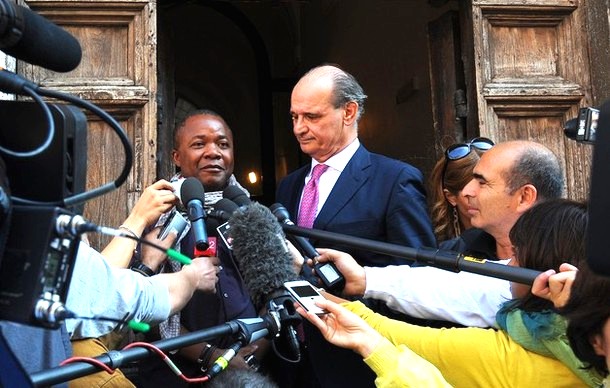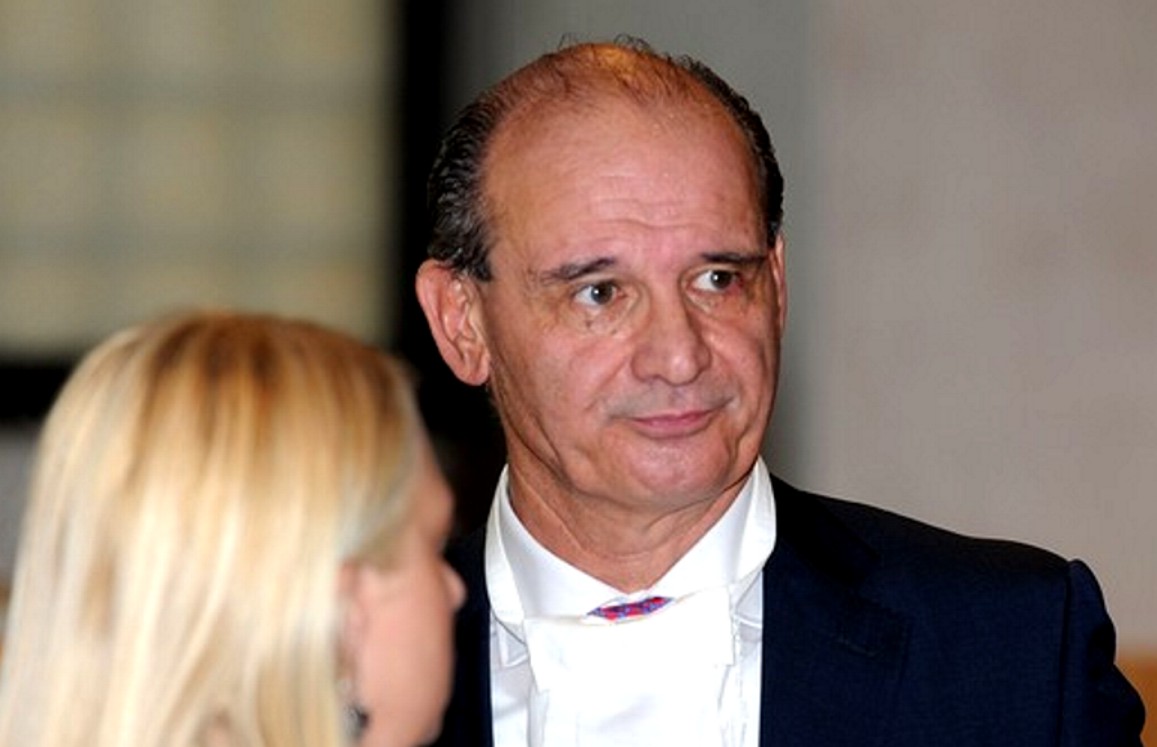
Category: Appeals 2009-2015
Monday, October 03, 2011
Knox And Sollecito Declared Not Guilty But With Angry Booing Outside The Courtroom
Posted by Peter Quennell
Van Watch: Around 8:00 PM Perugia Time And The Vans Are Reported Still At Capanne
Posted by Peter Quennell
The BBC and other news services are keeping a close eye on the gates of Capanne Prison.
When the vans carrying Sollecito and Knox exit and head back for Perugia (at the top of the massif in the shot below) the judges and lay judges will have something to announce.
Added: the two blue vans are on their way back to Perugia from Capanne and they should be arriving at the court about now. The defendants may enter at the level of the street tunnel that runs right under the court. If so then they walk up or catch an elevator.
When they were found guilty in 2009 they exited that same way. The court is one level below street level but if the windows had clear glass in them the views to the east would be terrific. The court is NOT underground as some of the media commentators have claimed.
Twentieth Appeal Session: Translated Transcript Of Amanda Knox’s Final Plea To The Court
Posted by Peter Quennell

The image above and Knox’s remarks below are from one of the live broadcasts of the pressroom feed.
Members of the court. Many times people have said I am some other person, people don’t understand whom I am. The only thing different from four years ago is what I have suffered. I lost a friend, a girlfriend, in the most brutal way in the most unexplained manner.
My trust in the police authorities has been betrayed. I have had to dealt with unfair and unfounded charges. I have paid with my life for things that I did not commit.
Four years ago I did not know what tragedy was. I have never faced so much anger before. I didn’t know how to interpret it. How did we react when we found out Meredith had been killed? I did not believe it. How was it possible?
Her bedroom was next to mine. She was killed in our home. If I had been there that night I would have died. The only difference is, I was not there. I trusted the police’s sense of duty and trust. I trusted them completely. I was betrayed on the night of November 5. I was manipulated.
I am not who they say I am. I am not violent. I don’t have a lack of respect for life. And I did not kill. I did not rape. I did not steal. I wasn’t there at the crime scene.
I had good relationships with everyone who lived in my flat. We all had good relationships. We helped each other. I shared my life, particularly with Meredith. We were friends. She was worried about me. She was very kind to me.
I have never run away from the truth. I insist after four desperate years, that our innocence is true and needs to be recognized. I want to go back home. I want to go back to my life. I don’t want my life and my future taken away from me for something that I didn’t do.
I am innocent. We do not deserve this. We never did anything to deserve this. I have the utmost respect to this court and the care that it has shown. Thank you.
Twentieth Appeal Session: Inside The Court This Morning Before The Procedings Started
Posted by Peter Quennell
Twentieth Appeal Session: The TV Media Assembled At Front Entrance Of The Court Today
Posted by Peter Quennell
Friday, September 30, 2011
Nineteenth Appeal Session: The Prosecution Seems To Be Looking Confident In Court
Posted by Peter Quennell
Wednesday, September 28, 2011
Pseudoinnocence: Is This Possibly The Predicament Of Amanda Knox?
Posted by Vivianna
In a dissertation titled Pseudoinnocence ““ An Invitation To Murder, Barbara Shore explores the phenomenon of “pseudoinnocence” in American culture as an inadequate response to the “conflagration of violence that encircles us today.” These are her introductory words:
“America is a country long haunted by its pseudoinnocence, by its blinding prolonged naivete. We are a culture that closes our eyes to all that is too painful to see, persuading ourselves that we have escaped, that we are neither interdependent nor vulnerable, or that we are victims.
We cannot come to terms with our own unwitting complicity in the destructiveness brought to ourselves or others. Capitalizing on such naivete, we fail to see how such “˜innocence that cannot include the demonic becomes evil’ (Rollo May 50).” (Dissertation Abstracts International Section A: Humanities and Social Sciences Mar, 2001 Vol 61(9-A))
Ms. Shores’ words, although published six years before the murder of Meredith Kercher even took place, represent an eerily accurate description of Amanda Knox’s predicament, even reflecting some of the terminology employed in Attorney Carlo Pacelli’s exposition on September 26, during the closing portion of the first appeal trial. As a reminder, Pacelli, who represents Patrick Lumumba in his civil suit against Knox, pointed out that Knox “has a split personality, fresh-faced, the daughter everyone would like, Saint Maria Goretti, and then with her histrionic side [she is] an impostor, she is a she-devil, satanic, diabolic, addicted to borderline behaviour.”
Although Pacelli’s words have been seen by some as too harsh, they carry a heavy implication mirrored in the above quote from Shore ““ that “innocence that cannot include the demonic becomes evil”; in other words, that if Knox cannot reconcile her two sides and seek atonement, she has no hope of redeeming herself as a human being.
I have argued before, in a comment posted here on the TJMK board, that Knox is not likely to make a confession in the near future due to the pressures exerted by her family’s innocence campaign. The innocence campaign is, in my opinion, just one of the factors which prevent Knox from admitting her direct involvement in the crime against Meredith Kercher.
The other factors may include her failure to reconcile the two parts of her persona (innocent, carefree, kind, compassionate young woman versus “diabolical” murderer) and perhaps a culturally-engrained inability to accept involvement in a destructive act. The discussion of these latter factors is perhaps best left to someone with formal training in psychology or sociology. What I would like to enlarge upon is my conviction that there is a direct correlation between the strength of the innocence campaign and Knox’s unwillingness to admit guilt.
I would like to draw your attention to a conversation between Knox, her mother (Edda Mellas), and her father (Curt Knox) which took place in the early days of the investigation, when Amanda had already been detained. This conversation will be well-known to those who have been consistently following this case as evidence that, in the early stages, Knox may have been inclined to give a confession. I have chosen not to include it, but it is readily available on both TJMK and PMF.
The reason why I believe this conversation to be so important is not only because it might contain the beginning of the confession, but also because it highlights the involvement of her family in defining her position. I would argue that, had Knox been left to her own devices, she might have cracked in the early stages and given an accurate description of that night’s events, saving both herself, her family, the victim’s family, and anyone involved in the trial considerable grief, time, money, and effort.
At that particular point in time, she may not have been as psychologically divided and conflicted, and she may have had an easier time accepting her criminal side and perhaps moving on to experience positive changes. It is, however, her parents’ firm belief in her innocence and in her inability to commit such a heinous crime that has consistently mired her in a difficult position.
As we well know, the Knox-Mellas family hired a PR firm, Gogerty-Mariott, to clean up Amanda’s image after unflattering stories started appearing in European tabloids. The PR campaign has grown exponentially from a few stories about Amanda’s childhood, complete with baby pictures, to what I consider to be a falsification of public opinion.
On the one hand, there is a concerted effort to offer inaccurate information about existing evidence (limiting the crime scene to Meredith’s room, stating that there is no evidence linking Amanda and Raffaele to the murder, pushing Rudy Guede as the “lone wolf” assassin, etc.), which is then fed to news outlets unwilling to do their own research and pushed upon the unsuspecting public via books, blogs, and forums. Then comes the even more insidious effort to falsify the public’s response to these stories, by hiring posters to write positive reviews for FOA books, post positive comments to inaccurate stories, and shout down any reasonable opposition.
Of course, this entire effort does not come cheaply, and rumors say that the PR campaign’s tab is around one million. This is an enormous debt to place on the shoulders of a young woman who already needs to contend with the guilt of having committed an incomprehensible, heinous, violent crime. While it is difficult to feel sympathy for any of Meredith’s killers, I find it impossible not to feel a certain amount of compassion for Amanda, who most likely never asked for this campaign to be initiated. How could she admit her role in this crime when a million dollars has already been spent to trumpet her innocence?
In addition to the material aspects, there are social and psychological aspects to contend with. While many of the FOA members are paid for their public appearances and statements (and may not harbor any personal opinions about the case), there seem to be individuals who are supporting Amanda’s innocence out of personal conviction. Some of them may have even donated money to help her family. How could she disappoint everyone who invested money and time into supporting her, from her own family to charitable strangers? How could she look them in the eye, after four years of lies and obfuscation, and admit that she was terrified of being punished, or incapable of seeing herself as a murderer?
Peter Quennell has suggested to me that this may be an example of “path dependence,” a concept used in both economics and social sciences to describe a scenario in which current actions and decisions are inexorably determined by past decisions. While my personal knowledge of path dependence is limited, I think that it is certainly applicable in this case and that it can be traced back to the prison conversation discussed before. During the conversation, Amanda’s parents indirectly communicated to her that the course had been set ““ that the legal team would handle all questions and that she was not to communicate her thoughts without supervision; also that a confession would be unacceptable because she was undeniably innocent.
As to why her family took this position, I think we can find the answer in the concept of pseudoinnocence ““ the inability to accept responsibility for and involvement in a terrible event, accompanied by a forced distancing from anything that could be considered troubling.
It is not a coincidence that Amanda has been consistently portrayed as a victim of the supposedly corrupt, medieval Italian justice system, as someone who has been “railroaded” in a “third-world” country, as her supporters want us to believe. It is more comforting to become a victim than to accept responsibility and acknowledge that Amanda’s problems may have started at home, long before she was on a plane for Perugia. I believe that the innocence campaign is not only meant to exculpate Amanda, but to also exculpate her family from any perceived contributions to the formation of a murderer.
As long as Amanda’s family continues to invest so much money and effort into supporting her innocence, and to maintain so much publicity around her case, I believe that any professional attempts to help Amanda admit her involvement will prove ineffective. This entire undertaking, combined with her own psychological dividedness and any cultural influences, is placing an enormous amount of unnecessary responsibility on Amanda and displacing a more appropriate type of responsibility.
Amanda, at this point, should feel responsibility towards Meredith and Meredith’s family primarily. While the murder itself cannot be reversed and no true solace offered, a confession would offer a certain amount of closure to those who knew and loved Meredith. Instead, Amanda’s sense of responsibility is being artificially redirected to not disappointing her own family and supporters, and to not betraying the trust they have placed in her innocence. Aside from being hurtful to the victim’s family, this situation is also damaging for Amanda herself, as it’s setting her on a path of continued “evil” rather than one of heal
Tuesday, September 27, 2011
Seventeenth Appeal Session: Tough Day Ahead For Raffaele Sollecito’s Lawyers In The Minefield
Posted by Peter Quennell
Today it will be Giulia Bongiorno and Luca Maori for Raffaele Sollecito. Important considerations to bear in mind:
1) There are still all these open questions assembled by lawyer and main poster SomeAlibi and Sollecito chose not to address them on the stand.
2) The Supreme Court has definitively shut down the argument of a possible lone wolf perpetrator and Guede in court accused Sollecito to his face.
3) Attempts to show that Guede did it with others (Alessi’s testimony) or two or three others did it (Aviello) both descended into farce.
4) A staged attempt by Bongiorno using a staff member to try to scale the wall of the house to Filomena’s window descended into farce.
5) Sollecito referred to Amanda Knox as a liar in his third alibi and in effect implicated her by saying that on the night she was absent for four hours.
6) Solleito has still not explained his phone record or computer record or how his DNA could have got onto Meredith’s bra clasp.
7) Sollecito has still not explained the other physical evidence tying him to the scene: how his bloody footprint ended up on the bathroom mat.
His family faces a trial for releasing an evidence tape to a TV station, and for attempting to subvert justice by involving national politicians. And the family have still not rebutted Aviello’s charge that a bribe was waved at him to testify.
Not a pretty mess, by any means. Good luck, Bongiorno and Maori.
Sixteenth Appeal Session: Lawyers For Patrick Lumumba And Victim’s Family Weigh In
Posted by Peter Quennell
1) Lawyers for Patrick Lumumba
A translation of the Umbria24 TV station report kindly provided by main poaster Tiziano.
MEREDITH, LUMUMBA’S LAWYER: “AMANDA IS DIABOLICAL” PATRICK: “I HAVE RELIVED THOSE DAYS”
“PATRICK IS THE SECOND VICTIM IN THIS CASE”
By Maurizio Troccoli
The civil parties are playing the last cards too in the Mez trial, represented by the lawyers of Meredith Kercher’s family and those of Patrick Lumumba, the young man who ended up in gaol with Amanda and Raffaele, because he was accused of being the author of the murder by the young American.
A few days before the sentence, which should come on Monday, and the reconstructions of what happened that night between the 1st and 2nd November, 2007 in the cottage in via della Pergola in Perugia, go on stage. A bloody murder which has seen the two ex-lovers condemned to 26 years prison for Amanda, and 25 for Rafaele at the first stage [trial}.
Patrick Lumumba was set free after a few days of detention thanks to an “iron clad alibi” which put him in a different place from “the house of horrors”, that is to say in his night spot, together with a Swiss professor, Roman Mero, who witnessed this, thus helping the young man to get back his freedom.
That testimony was sufficient to convince the magistrates - notwithstanding the accusations of Amanda - of his “complete non-involvement in the facts”, which originated in the questioning at the Perugia police headquarters on November 6th, 2007.
Patrick is still waiting for justice to be done, to be compensated for what was taken from him, for payment for the person who was stained by such a serious crime which sees him as “the second victim of this tragedy”, as his defender Claudio Pacelli said this morning. “Patrick has paid a lot, not only for his imprisonment but also for the damage to his image, said Pacelli. “My client ended up in the newspapers and on TV all over the world as the author of the murder of the young Englishwoman.”
“During the appearance of my lawyer - [Patrick] says ““ it is as though I had gone back, reliving that really sad period. We hope that justice is done. Today I relived those moments - the night when the professor came to the pub saying that he wanted to say good-bye because that next day he would be going back to Zurich,” Lumumba said, “However he came to save me, with neither I nor he realising this.”
“Amanda falsely accused an innocent person - lawyer Pacelli affirmed - exclusively to avoid being discovered. A classic scheme. Amanda is a consummate actress, a very intelligent girl, astute and cunning. One who really knows how to inspire the emotions of whoever is listening to her.”
And the fault of what happened to the damage of Patrick resides completely in “the young American, Amanda”, whose profile the lawyer drew in court, defining her “an explosive mixture of drugs, sex and alcohol.”
He added, “Quite the opposite of sweet, she has a split personality, fresh-faced, the daughter everyone would like, Saint Maria Goretti, and then with her histrionic side [she is] an impostor, she is a she-devil, satanic, diabolic, addicted to borderline behaviour.
What Amanda says when she claims that Patrick’s name was suggested to her by the police is a huge lie. She was the one to arbitrarily choose to point to Patrick as the guilty on, in order to distance herself from suspicion,” the lawyer said further.
2) Lawyers for the victim’s family
[translation to follow]
Monday, September 26, 2011
Sixteenth Appeal Session: Images Of Main Participants Before Start Of Court Today
Posted by Peter Quennell





























